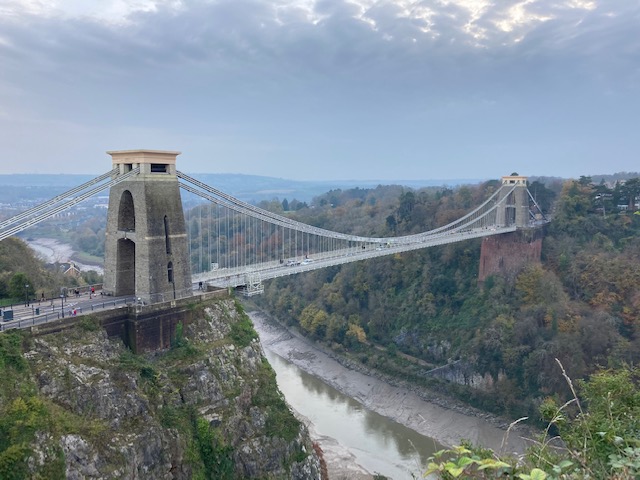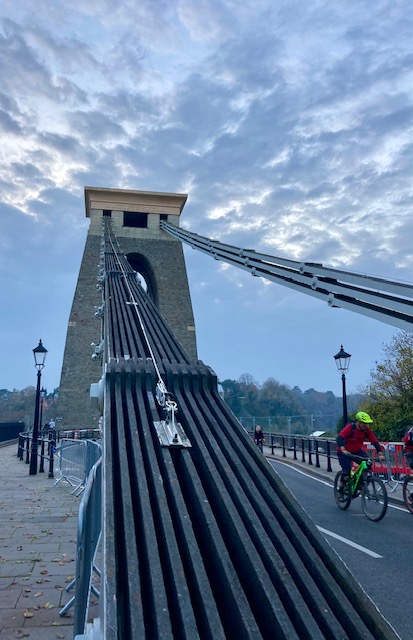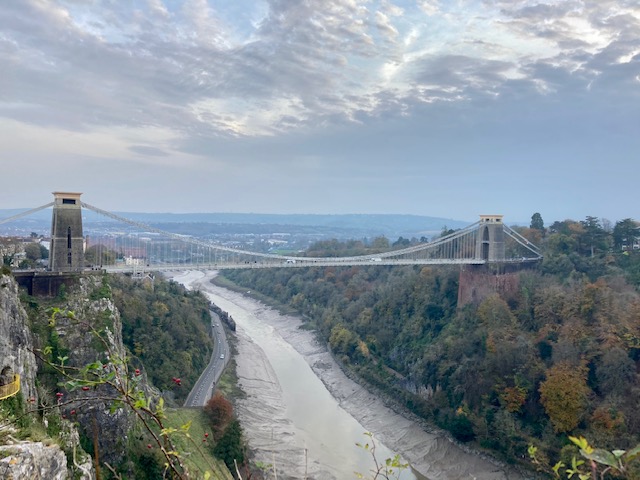Clifton Suspension Bridge
Contents |
[edit] Introduction
Clifton Suspension Bridge links Clifton in Bristol to Leigh Woods in Somerset spanning the River Avon and the Avon Gorge.
[edit] History
The Clifton Suspension Bridge was built between 1831 and 1864 based on an idea first proposed in 1753. Its completion 111 years later was hindered by financial constraints and political complications.
Initial funding for the project came from a deceased Bristol wine merchant named William Vick whose idea a bridge was. When he died in 1753, Vick left £1,000 in his will along with specific instructions to use the money (and the accumulated interest, once it reached a total of £10,000) to construct the bridge.
By 1829 the funds had grown to £8,000. While this was considered insufficient for the entire project (which was expected to cost as much as 10 times more), it was enough to prompt organisers to hold a competition for the best design. This resulted in 22 entries, including four submitted by Isambard Kingdom Brunel. Of the original designs, 17 were rejected on the basis of appearance, materials (Vick's will specified a stone bridge) or cost.
Scottish civil engineer Thomas Telford was brought in to make a selection from the final five entries, and rejected all of them. He then proceeded to produce his own design while additional funding was arranged.
After the Clifton Bridge Bill was enacted in 1830, planners were able to consider designs for a wrought iron suspension bridge (rather than the original plan for stone) that could generate funds through the collection of tolls. Still, the proposed design created by Telford was too expensive; so was a revised one from Brunel.
A second competition held in 1831 resulted in Brunel being awarded the contract as project engineer. It was his first significant commission; he was just 24-years-old at the time.
[edit] Construction delays
The start of construction took place in June 1831. Work stopped during the Bristol Riots, which occurred four months into construction. It resumed in 1836, but halted again in 1843. At this point, only one aspect of the project was complete and funding was exhausted.
Brunel’s original sphinx-topped towers had been scaled back into a rougher, simpler design. These were constructed on both sides of the gorge. Brunel also designed a device known as ‘the suspended traveller’ (an iron bar and basket) to draw materials and personnel from one side of the gorge to the other during construction.
Work on the bridge would not resume again until 1862. During his lifetime, Brunel would describe the bridge as 'my first child, my darling’. However, he died in 1859 - five years before its completion.
[edit] Resumption of construction
Funds for the continuation of work were raised with help from the Institution of Civil Engineers (ICE). Although Brunel’s colleagues at ICE felt this would be an appropriate memorial to his achievements, some changes were made to his original design. Sir John Hawkshaw and William Henry Barlow worked together to come up with modifications that included widening the road and increasing the number of suspension chains (from two to three).
Modern computer analysis shows that his calculations for the joints between the wrought iron links that make up the bridge's chain were nearly perfect in terms of accommodating the weight they were required to support.
Work restarted 1862 under the supervision of Hawkshaw and Barlow and was completed in 1864.
[edit] Post-construction details
The Clifton Suspension Bridge is now a Grade I listed structure, recognised for its achievements in engineering. Despite the delays, it is considered by some to be one of the most significant projects built during the Victorian era.
There are several noteworthy details about the bridge.
- The toll that is collected for crossing the bridge goes towards its maintenance.
- The bridge towers are not identical. The Clifton side tower has cut outs while the Leigh Woods sides have pointed arches. In 2002, 12 chambers and tunnels were discovered in the Leigh Woods tower.
- The bridge spans 214 metres (702 feet) between its two towers and stands 76 metres (245 feet) above the River Avon at high tide.
- The bridge weighs 1,500 tonnes. It is made up of 3,500 load bearing bolts and chains that stretch 20 metres below ground (not 20 miles - this is an often repeated mistake which originated from a misprint in a book).
This image shows how the Clifton tower (left) differs from the Leigh Woods tower (right).
[edit] Legends of the bridge
Folklore associated with the bridge includes the story of a heartbroken young woman named Sarah Ann Henley who attempted suicide by jumping from the bridge in 1885. According to the tale, her effort was thwarted by her voluminous skirts and weather conditions. Her skirts were lifted by strong gusts of wind, which served to parachute her safely to the muddy banks of the River Avon. Although a cabman refused to take her to hospital due to her dirty condition, she was eventually examined by medical professionals who said she was unharmed, although suffering from shock. She later married another suitor and died in 1948 at the age of 85.
The Clifton Suspension Bridge is also associated with the English engineer and inventor, Sarah Guppy (5 November 1770 – 24 August 1852). As the first woman to patent a chain bridge, Guppy came up with her version in 1811. Guppy's design was never executed and is not thought to have had any impact on Brunel's plans for the Clifton Suspension Bridge. However, her son, Thomas Guppy, did work with Brunel on the SS Great Britain and other projects.
[edit] Related articles on Designing Buildings
- Bridge construction.
- Bridges of the world.
- Bridge structures.
- Civil engineering dream projects.
- Five bridges worth visiting during a UK staycation.
- Funicular.
- Going the extra mile to extend the lifespan of the Menai Suspension Bridge.
- Institution of Civil Engineers ICE.
- London Bridge and its houses, c1209-1761.
- Navigable aqueduct.
- Pylon.
- The architecture of British bridges.
- Who is the greatest engineer?
- Wrought iron.
[edit] External resources
- Clifton Suspension Bridge Trust, Did Sarah Guppy Design The Clifton Suspension Bridge?
- Clifton Suspension Bridge Trust, Stories From The Archives: Sarah Ann Henley (8 July 1862 – 31 March 1948).
Featured articles and news
International Electrician Day, 10 June 2025
Celebrating the role of electrical engineers from André-Marie Amperè, today and for the future.
New guide for clients launched at Houses of Parliament
'There has never been a more important time for clients to step up and ...ask the right questions'
The impact of recycled slate tiles
Innovation across the decades.
EPC changes for existing buildings
Changes and their context as the new RdSAP methodology comes into use from 15 June.
Skills England publishes Sector skills needs assessments
Priority areas relating to the built environment highlighted and described in brief.
BSRIA HVAC Market Watch - May 2025 Edition
Heat Pump Market Outlook: Policy, Performance & Refrigerant Trends for 2025–2028.
Committing to EDI in construction with CIOB
Built Environment professional bodies deepen commitment to EDI with two new signatories: CIAT and CICES.
Government Grenfell progress report at a glance
Line by line recomendation overview, with links to more details.
An engaging and lively review of his professional life.
Sustainable heating for listed buildings
A problem that needs to be approached intelligently.
50th Golden anniversary ECA Edmundson apprentice award
Deadline for entries has been extended to Friday 27 June, so don't miss out!
CIAT at the London Festival of Architecture
Designing for Everyone: Breaking Barriers in Inclusive Architecture.
Mixed reactions to apprenticeship and skills reform 2025
A 'welcome shift' for some and a 'backwards step' for others.
Licensing construction in the UK
As the latest report and proposal to licence builders reaches Parliament.
Building Safety Alliance golden thread guidance
Extensive excel checklist of information with guidance document freely accessible.
Fair Payment Code and other payment initiatives
For fair and late payments, need to work together to add value.
Pre-planning delivery programmes and delay penalties
Proposed for housebuilders in government reform: Speeding Up Build Out.
High street health: converting a building for healthcare uses
The benefits of health centres acting as new anchor sites in the high street.




























